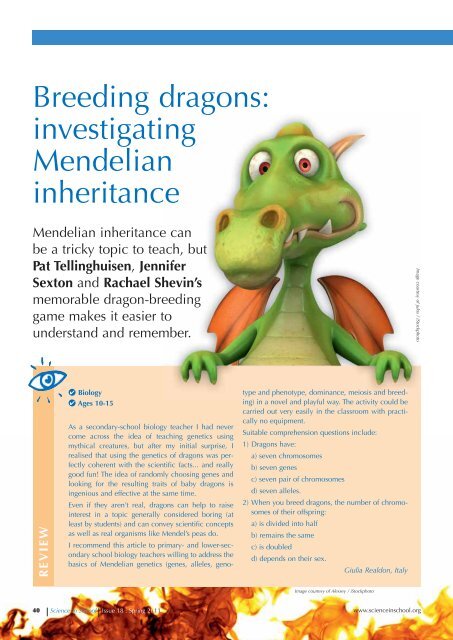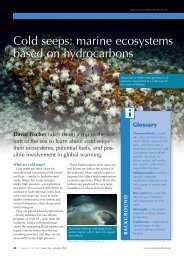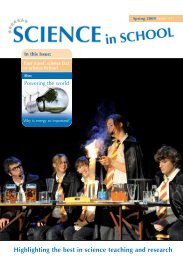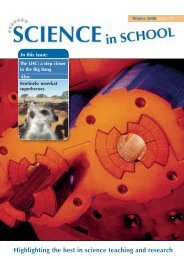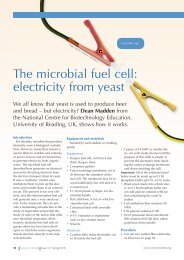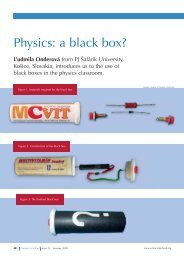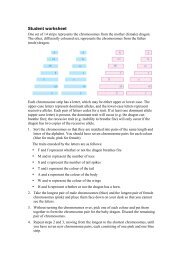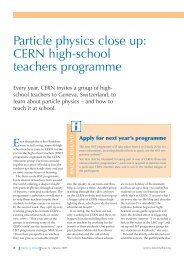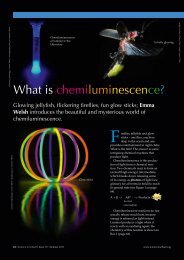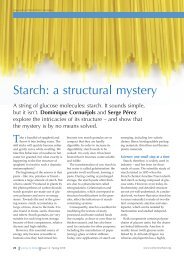PDF (English) - Science in School
PDF (English) - Science in School
PDF (English) - Science in School
Create successful ePaper yourself
Turn your PDF publications into a flip-book with our unique Google optimized e-Paper software.
Breed<strong>in</strong>g dragons:<br />
<strong>in</strong>vestigat<strong>in</strong>g<br />
Mendelian<br />
<strong>in</strong>heritance<br />
Mendelian <strong>in</strong>heritance can<br />
be a tricky topic to teach, but<br />
Pat Tell<strong>in</strong>ghuisen, Jennifer<br />
Sexton and Rachael Shev<strong>in</strong>’s<br />
memorable dragon-breed<strong>in</strong>g<br />
game makes it easier to<br />
understand and remember.<br />
Image courtesy of julos / iStockphoto<br />
REVIEW<br />
Biology<br />
Ages 10-15<br />
As a secondary-school biology teacher I had never<br />
come across the idea of teach<strong>in</strong>g genetics us<strong>in</strong>g<br />
mythical creatures, but after my <strong>in</strong>itial surprise, I<br />
realised that us<strong>in</strong>g the genetics of dragons was perfectly<br />
coherent with the scientific facts... and really<br />
good fun! The idea of randomly choos<strong>in</strong>g genes and<br />
look<strong>in</strong>g for the result<strong>in</strong>g traits of baby dragons is<br />
<strong>in</strong>genious and effective at the same time.<br />
Even if they aren’t real, dragons can help to raise<br />
<strong>in</strong>terest <strong>in</strong> a topic generally considered bor<strong>in</strong>g (at<br />
least by students) and can convey scientific concepts<br />
as well as real organisms like Mendel’s peas do.<br />
I recommend this article to primary- and lower-secondary<br />
school biology teachers will<strong>in</strong>g to address the<br />
basics of Mendelian genetics (genes, alleles, genotype<br />
and phenotype, dom<strong>in</strong>ance, meiosis and breed<strong>in</strong>g)<br />
<strong>in</strong> a novel and playful way. The activity could be<br />
carried out very easily <strong>in</strong> the classroom with practically<br />
no equipment.<br />
Suitable comprehension questions <strong>in</strong>clude:<br />
1) Dragons have:<br />
a) seven chromosomes<br />
b) seven genes<br />
c) seven pair of chromosomes<br />
d) seven alleles.<br />
2) When you breed dragons, the number of chromosomes<br />
of their offspr<strong>in</strong>g:<br />
a) is divided <strong>in</strong>to half<br />
b) rema<strong>in</strong>s the same<br />
c) is doubled<br />
d) depends on their sex.<br />
Giulia Realdon, Italy<br />
Image courtesy of Alexsey / iStockphoto<br />
40 <strong>Science</strong> <strong>in</strong> <strong>School</strong> Issue 18 : Spr<strong>in</strong>g 2011<br />
www.science<strong>in</strong>school.org
Teach<strong>in</strong>g activities<br />
Dragons may be mythical animals,<br />
but they can still be<br />
good tools for <strong>in</strong>vestigat<strong>in</strong>g<br />
Mendelian <strong>in</strong>heritance. In the follow<strong>in</strong>g<br />
activity, students will ‘breed’ baby<br />
dragons, us<strong>in</strong>g paper chromosomes to<br />
determ<strong>in</strong>e the genotype and phenotype.<br />
The activity has been tested with<br />
students aged 12-13, and generally<br />
takes one lesson – about 45 to 60 m<strong>in</strong>utes.<br />
Materials<br />
For the whole class<br />
· A DNA model<br />
· A picture of a chromosome<br />
For each student<br />
· A set of chromosome strips <strong>in</strong> two<br />
colours (14 p<strong>in</strong>k strips for the<br />
mother and 14 blue strips for the<br />
father)<br />
· A student worksheet<br />
· Crayons (at least four colours)<br />
The chromosome strips, Tables 1-3<br />
from the worksheet and the basic<br />
dragon draw<strong>in</strong>g can be found on<br />
pages 42/43 or downloaded from the<br />
<strong>Science</strong> <strong>in</strong> <strong>School</strong> website w1 .<br />
Procedure<br />
Us<strong>in</strong>g the <strong>in</strong>formation below, <strong>in</strong>troduce<br />
the dragon story and the<br />
required background for the activity to<br />
the students. Then hand out the materials<br />
and let the students follow the<br />
<strong>in</strong>structions on the student worksheet.<br />
Tables 1–3 can also be downloaded<br />
from the <strong>Science</strong> <strong>in</strong> <strong>School</strong> website w1 .<br />
The story<br />
Dragons are a curious type of creature.<br />
Amaz<strong>in</strong>gly, though, their genetics<br />
is very similar to that of humans –<br />
or even gu<strong>in</strong>ea pigs. Many schools<br />
keep pet gu<strong>in</strong>ea pigs, but wouldn’t it<br />
be much more excit<strong>in</strong>g to keep a herd<br />
of dragons? Unfortunately, dragons<br />
are very expensive, so your school<br />
can only afford two – one of each sex.<br />
The purpose of this activity is to<br />
determ<strong>in</strong>e what k<strong>in</strong>ds of dragon you<br />
Image courtesy of Darryl Leja, NHGRI / NIH<br />
A gene<br />
Deoxyribonucleic<br />
Acid (DNA)<br />
Chromosome<br />
How DNA is packaged <strong>in</strong>to<br />
chromosomes (not to scale)<br />
could have <strong>in</strong> your herd when (or if)<br />
your two dragons decide to mate.<br />
Background for the students<br />
Each cell <strong>in</strong> all liv<strong>in</strong>g organisms<br />
conta<strong>in</strong>s hereditary <strong>in</strong>formation that<br />
is encoded by a molecule called<br />
deoxyribonucleic acid (DNA): show<br />
students the DNA model. DNA is an<br />
extremely long and sk<strong>in</strong>ny molecule,<br />
which when all coiled up and<br />
bunched together, is called a chromosome:<br />
show students the picture of a<br />
chromosome. Each chromosome is a<br />
separate piece of DNA, so a cell with<br />
eight chromosomes has eight long<br />
pieces of DNA.<br />
A gene is a segment of the long<br />
DNA molecule. Different genes may<br />
be different lengths and each gene is a<br />
code for how a certa<strong>in</strong> polypeptide<br />
should be made. One or more<br />
polypeptides form a prote<strong>in</strong>, which<br />
can generally be sorted <strong>in</strong>to two different<br />
types: those that run the chemical<br />
reactions <strong>in</strong> your body (enzymes),<br />
and those that are the structural components<br />
of your body (structural prote<strong>in</strong>s).<br />
How an organism looks and<br />
functions is a result of the cumulative<br />
effect of both these types of prote<strong>in</strong>.<br />
Any organism that has ‘parents’ has<br />
an even number of chromosomes,<br />
because half of the chromosomes<br />
come from the ‘father’ and the other<br />
A<br />
a<br />
Image courtesy of Nicola Graf<br />
Different alleles of the same<br />
gene (not to scale)<br />
half from the ‘mother’. For example,<br />
<strong>in</strong> plants, a pollen gra<strong>in</strong> is the paternal<br />
contribution and an ovule is the<br />
maternal contribution. These two cells<br />
comb<strong>in</strong>e to make a s<strong>in</strong>gle cell, which<br />
will grow <strong>in</strong>to a seed (the offspr<strong>in</strong>g).<br />
Humans have 46 chromosomes,<br />
sorted <strong>in</strong>to 23 pairs. One chromosome<br />
<strong>in</strong> each of the 23 pairs is from the person’s<br />
father, the other from his or her<br />
mother. S<strong>in</strong>ce chromosomes come <strong>in</strong><br />
pairs, genes do too. One gene is located<br />
on one member of the chromosome<br />
pair; the other gene is <strong>in</strong> the<br />
same location on the other chromosome.<br />
The gene ‘pair’ is technically<br />
referred to as a ‘gene’, as both members<br />
of the pair encode the same trait.<br />
For any gene, a variety of different<br />
forms – known as alleles – may exist,<br />
but each person can have a maximum<br />
of only two alleles (one from the<br />
mother, and one from the father). The<br />
two copies of the gene that a person<br />
has may be the same or different alleles.<br />
Our dragons have 14 chromosomes<br />
<strong>in</strong> seven pairs, and we will look at<br />
only one gene on each of the pairs.<br />
We will be <strong>in</strong>vestigat<strong>in</strong>g seven different<br />
traits (e.g. the ability to breathe<br />
fire), each of which is controlled by a<br />
s<strong>in</strong>gle gene – we say that such a trait<br />
is monogenic. Each of the seven genes<br />
has two alleles.<br />
www.science<strong>in</strong>school.org <strong>Science</strong> <strong>in</strong> <strong>School</strong> Issue 18 : Spr<strong>in</strong>g 2011 41
Student worksheet<br />
One set of 14 strips represents the chromosomes from<br />
the mother (female) dragon. The other, differently<br />
coloured set, represents the chromosomes from the father<br />
(male) dragon.<br />
Each chromosome strip has a letter, which may be either<br />
upper or lower case. The upper-case letters represent<br />
dom<strong>in</strong>ant alleles, and the lower-case letters represent<br />
recessive alleles. Each pair of letters codes for a trait. If at<br />
least one dom<strong>in</strong>ant allele (upper-case letter) is present, the<br />
dom<strong>in</strong>ant trait will occur (e.g. the dragon can breathe fire);<br />
the recessive trait (e.g. <strong>in</strong>ability to breathe fire) will only<br />
occur if the dragon has two copies of the recessive allele.<br />
1. Sort the chromosomes so that they are matched <strong>in</strong>to<br />
pairs of the same length and letter of the alphabet. You<br />
should have seven chromosome pairs for each colour<br />
(blue for male, p<strong>in</strong>k for female).<br />
The traits encoded by the letters are as follows:<br />
· F and f represent whether or not the dragon<br />
breathes fire<br />
· M and m represent the number of toes<br />
· S and s represent the number of tail spikes<br />
· T and t represent the colour of the tail<br />
· A and a represent the colour of the body<br />
· W and w represent the colour of the w<strong>in</strong>gs<br />
· H and h represent whether or not the dragon has a<br />
horn.<br />
2. Take the longest pair of male chromosomes (blue) and<br />
the longest pair of female chromosomes (p<strong>in</strong>k) and<br />
place them face down on your desk so that you cannot<br />
see the letters.<br />
3. Without turn<strong>in</strong>g the chromosomes over, pick one of<br />
each colour and put them together to form the chromosome<br />
pair for the baby dragon. Discard the rema<strong>in</strong><strong>in</strong>g<br />
pair of chromosomes.<br />
4. Repeat steps 2 and 3, mov<strong>in</strong>g from the longest to the<br />
shortest chromosomes, until you have seven new chromosome<br />
pairs, each consist<strong>in</strong>g of one p<strong>in</strong>k and one<br />
blue strip.<br />
5. Turn over the seven pairs of chromosomes of the new<br />
baby dragon. For each pair, record the letter on the blue<br />
chromosome <strong>in</strong> the ‘Male gene’ column <strong>in</strong> Table 1 and<br />
the letter of the p<strong>in</strong>k chromosome <strong>in</strong> the ‘Female gene’<br />
column. Be sure you copy the letters exactly, not<strong>in</strong>g<br />
whether they are upper or lower case.<br />
6. Return all the chromosomes to their proper bags.<br />
7. Record which alleles (letters) your dragon has for each<br />
trait, and enter them <strong>in</strong> the second column of Table 2.<br />
We refer to the two alleles <strong>in</strong>herited for a particular<br />
gene as the genotype (e.g. TT). The observable traits of<br />
an <strong>in</strong>dividual (e.g. a red tail) are known as the phenotype.<br />
8. Refer to Table 3 to determ<strong>in</strong>e which alleles are dom<strong>in</strong>ant<br />
or recessive for each trait, then enter the phenotype<br />
of your dragon <strong>in</strong> Table 2.<br />
9. Now you are ready to draw your baby dragon: colour<br />
and add the relevant body parts to the basic dragon<br />
picture (which can also be downloaded from the <strong>Science</strong><br />
<strong>in</strong> <strong>School</strong> website w1 ). See Table 3 for suggestions as to<br />
how the additional body parts can be drawn.<br />
A<br />
a<br />
A<br />
a<br />
H<br />
h<br />
H<br />
h<br />
W<br />
w<br />
W<br />
w<br />
T<br />
t<br />
T<br />
t<br />
S<br />
s<br />
S<br />
s<br />
M<br />
m<br />
M<br />
m<br />
F<br />
f<br />
F<br />
f<br />
42 <strong>Science</strong> <strong>in</strong> <strong>School</strong> Issue 18 : Spr<strong>in</strong>g 2011<br />
www.science<strong>in</strong>school.org
Teach<strong>in</strong>g activities<br />
Male gene<br />
(blue)<br />
Female gene<br />
(p<strong>in</strong>k)<br />
Trait Genotype Phenotype<br />
Fire/No fire (F/f)<br />
Toes (M/m)<br />
Spikes on tail (S/s)<br />
Tail colour (T/t)<br />
W<strong>in</strong>g colour (W/w)<br />
Horn/no horn (H/h)<br />
Body colour (A/a)<br />
Table 2: Genotype and phenotype of your baby dragon<br />
Table 1: The genes your dragon<br />
has <strong>in</strong>herited from its parents<br />
Genotype<br />
FF or Ff<br />
ff<br />
MM or Mm<br />
mm<br />
SS or Ss<br />
ss<br />
TT or Tt<br />
tt<br />
WW or Ww<br />
ww<br />
HH or Hh<br />
hh<br />
AA or Aa<br />
aa<br />
Phenotype<br />
Breathes fire<br />
Does not breathe fire<br />
Four toes<br />
Three toes (all dragons<br />
have at least three toes)<br />
Five spikes on tail<br />
Four spikes on tail<br />
(all dragons<br />
have at least four<br />
tail spikes)<br />
Red tail<br />
Yellow tail<br />
Red w<strong>in</strong>gs<br />
Yellow w<strong>in</strong>gs<br />
Horn<br />
No horn<br />
Blue body and head<br />
Green body and head<br />
The basic dragon<br />
picture<br />
Table 3: Translat<strong>in</strong>g the dragon genotype <strong>in</strong>to the phenotype<br />
www.science<strong>in</strong>school.org <strong>Science</strong> <strong>in</strong> <strong>School</strong> Issue 18 : Spr<strong>in</strong>g 2011 43
Variations<br />
Codom<strong>in</strong>ance<br />
To <strong>in</strong>troduce the concept of codom<strong>in</strong>ance,<br />
you can extend the activity by<br />
swapp<strong>in</strong>g the relevant materials concern<strong>in</strong>g<br />
the body colour trait (genotype<br />
Aa) for the follow<strong>in</strong>g ones with<br />
the genotypes A/Ä/a, where A and Ä<br />
are codom<strong>in</strong>ant and a is recessive:<br />
Genotype<br />
AA or Aa<br />
ÄÄ or Äa<br />
AÄ<br />
aa<br />
Trait Genotype Phenotype<br />
Body colour<br />
(A/Ä/a)<br />
Phenotype<br />
Blue body and head<br />
Black body and head<br />
Stripy blue and black<br />
body and head<br />
White body and head<br />
Table 1a: Translat<strong>in</strong>g the dragon genotype<br />
<strong>in</strong>to the phenotype (extension for codom<strong>in</strong>ance<br />
example)<br />
Table 2a: Genotype and phenotype of<br />
your baby dragon (extension for codom<strong>in</strong>ance<br />
example)<br />
Chromosome set 1<br />
For the father<br />
For the mother<br />
Chromosome set 2<br />
For the father<br />
For the mother<br />
A<br />
A<br />
Other variations<br />
Instead of draw<strong>in</strong>g dragon parts,<br />
you could have your students draw<br />
other mythical creatures, or even<br />
build them, for example from marsh<br />
a<br />
A<br />
Ä<br />
Ä<br />
Ä<br />
A<br />
Acknowledgements<br />
This activity is based on an idea by<br />
Patti Soderberg, adapted with permission<br />
from The <strong>Science</strong> Teacher (see<br />
Soderberg, 1992). Her reebops lesson<br />
was then adapted by the authors.<br />
Credit for the chromosome strips goes<br />
to Nancy Clark w2 , and Marlene Rau,<br />
editor of <strong>Science</strong> <strong>in</strong> <strong>School</strong>, <strong>in</strong>cluded<br />
the codom<strong>in</strong>ance example.<br />
References<br />
Soderberg P (1992) Marshmallow<br />
meiosis. The <strong>Science</strong> Teacher 59(8): 28-<br />
31. The article can be freely downloaded<br />
from the <strong>Science</strong> <strong>in</strong> <strong>School</strong> website,<br />
with k<strong>in</strong>d permission from The<br />
<strong>Science</strong> Teacher. See:<br />
www.science<strong>in</strong>school.org/2011/issue<br />
18/dragons#resources<br />
Web references<br />
w1 – The chromosome strips, tables<br />
and the basic picture for this activity<br />
can be downloaded from the<br />
<strong>Science</strong> <strong>in</strong> <strong>School</strong> website. See:<br />
www.science<strong>in</strong>school.org/2011/<br />
issue18/dragons#resources<br />
w2 – Retired US science teacher<br />
Nancy Clark’s collection of classroom<br />
resources can be found onl<strong>in</strong>e:<br />
www.nclark.net<br />
w3 – F<strong>in</strong>d out more about the<br />
Vanderbilt Student Volunteers for<br />
<strong>Science</strong> here: http://studentorgs.<br />
vanderbilt.edu/vsvs<br />
Resources<br />
The Scottish ‘Gene jury’ project proposes<br />
a ‘make a baby’ game, focus<strong>in</strong>g<br />
on pre-implantation diagnostics<br />
and genetics. See the Gene jury<br />
website (www.biology.ed.ac.uk/<br />
projects/GeneJury) or use the direct<br />
l<strong>in</strong>k: http://t<strong>in</strong>yurl.com/6edlhnq<br />
To learn more about genetic diseases,<br />
and the research <strong>in</strong>to them, see:<br />
Patterson L (2009) Gett<strong>in</strong>g a grip on<br />
genetic diseases. <strong>Science</strong> <strong>in</strong> <strong>School</strong> 13:<br />
53-58. www.science<strong>in</strong>school.org/<br />
2009/issue13/<strong>in</strong>sight<br />
For our two-part article on molecular<br />
evolution and the genetics beh<strong>in</strong>d<br />
positive selection of certa<strong>in</strong> alleles,<br />
see:<br />
Bryk J (2010) Natural selection at<br />
the molecular level. <strong>Science</strong> <strong>in</strong> <strong>School</strong><br />
14: 58-62. www.science<strong>in</strong>school.org<br />
/2010/issue14/evolution<br />
Bryk J (2010) Human evolution:<br />
test<strong>in</strong>g the molecular basis. <strong>Science</strong><br />
<strong>in</strong> <strong>School</strong> 17: 11-16.www.science<strong>in</strong>school.<br />
org/2010/issue17/evolution<br />
Stay<strong>in</strong>g with the subject of genetics<br />
and evolution, a simple way to<br />
teach the Hardy-We<strong>in</strong>berg pr<strong>in</strong>ciple<br />
<strong>in</strong> class is described here:<br />
Pongsophon P et al. (2007)<br />
Count<strong>in</strong>g Buttons: demonstrat<strong>in</strong>g<br />
the Hardy-We<strong>in</strong>berg pr<strong>in</strong>ciple.<br />
<strong>Science</strong> <strong>in</strong> <strong>School</strong> 6: 30-35.<br />
www.science<strong>in</strong>school.org/2007/<br />
issue6/hardywe<strong>in</strong>berg<br />
Try the UK <strong>Science</strong> museum’s onl<strong>in</strong>e<br />
game ‘Th<strong>in</strong>gdom’ to learn about<br />
genetics while creat<strong>in</strong>g your own<br />
fictional organism. See:<br />
www.sciencemuseum.org.uk/<br />
WhoAmI/Th<strong>in</strong>gdom.aspx<br />
If you enjoyed this article, why not<br />
browse our full collection of biology<br />
articles? See:<br />
www.science<strong>in</strong>school.org/biology<br />
Patricia Tell<strong>in</strong>ghuisen is the Director<br />
of the Vanderbilt Student Volunteers<br />
for <strong>Science</strong> (VSVS) w3 and Faculty<br />
Advisor at Vanderbilt University,<br />
Nashville, Tennessee, USA. Jennifer<br />
Sexton and Rachel Shev<strong>in</strong> were<br />
undergraduate laboratory assistants<br />
at the VSVS.<br />
To learn how to use<br />
this code, see page 1.<br />
44 <strong>Science</strong> <strong>in</strong> <strong>School</strong> Issue 18 : Spr<strong>in</strong>g 2011<br />
www.science<strong>in</strong>school.org


